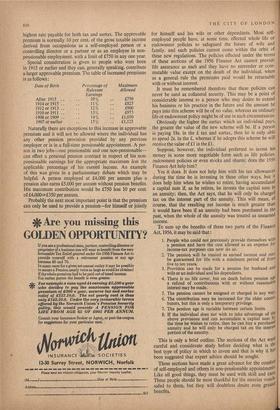The Self-Employed
By A. R. PENTERVILLE T long last two parts of the Millard Tucker Report received the light of legislation in the 1956 Finance The most important point is that an approved premium will be allowed as a deduction from gross income for tax purposes, which means that tax is saved on the premium at the highest rate payable for both tax and surtax. The approvable premium is normally 10 per cent. of the gross taxable income derived from occupations as a self-employed person or a controlling director or a partner or as an employee in non- pensionable employment, with a limit of £750 in any one year.
Special consideration is given to people who were born in 1915 or earlier and they can, generally speaking, contribute a larger approvable premium. The table of increased premiums is as follows : Date of Birth Percentage of Maximum
Relevant Earnings
Allowed After 1915 .. 10% . • £750 1914 or 1915 .. 11%
£825 1912 or 1913 .. 12%
£900 1910 or 1911 .. 13%
£975 1908 or 1909 .. 14%
£1,050 1907 or earlier 15%
£1,125
Naturally there are exceptions to this increase in approvable premium and it will not be allowed where the individual has any other pension provision provided by any previous employer or is in a full-time pensionable appointment. A per- son in two jobs—one pensionable and one non-pensionable- can effect a personal pension contract in respect of his non- pensionable earnings for the appropriate maximum less the applicable percentage of his earned income. An example of this was given in a parliamentary debate which may be helpful. A person employed at £4,000 per annum plus a pension also earns £5,000 per annum without pension benefits. His maximum contribution would be £750 less 10 per cent. of £4,000=£350 per annum.
Probably the next most important point is that the premium can only be used to provide a pension—for himself or jointly for himself and his wife or other dependants. Most self- employed people have, at some time, effected whole life or endowment policies to safeguard the future of wife and family. and such policies cannot come within the orbit of these new regulations. The policies effected under the terms of these sections of the 1956 Finance Act cannot provide life assurance as such and they have no surrender or com- mutable value except on the death of the individual, when as a general rule the premiums paid would be returnable with or without interest.
It must be remembered therefore that these policies can never be used as collateral security. This may be a point of considerable interest to a person who may desire to extend his business or his practice in the future and the amount he pays into this scheme will be of no value. whereas an ordinary life or endowment policy might he of use in such circumstances.
Obviously the higher the surtax which an individual pays, the greater the value of the new scheme will he. If a person is paying 18s. in the £ tax and surtax, then he is only able to spend 2s. in the E, whereas if he adopts this scheme he will receive the value of £1 in the £1.
Suppose, however, the individual preferred to invest his money in some more negotiable form such as life policies. endowment policies or even stocks and shares; does the 1956 Finance Act help him?
Yes it does. It does not help him with his tax allowances during the time he is investing in these other ways, but it does help him when he wishes to retire, having accumulated a capital sum if, as he retires, he invests the capital sum in an annuity; then, the Act says, that he will only be charged tax on the interest part of the annuity. This will mean, of course, that the resulting net income is much greater than it would have been if an annuity had been purchased in the past, when the whole of the annuity was treated as unearned income.
To sum up the benefits of these two parts of the Finance Act, 1956, it may be said that : 1. People who could not previously provide themselves with a pension and have the cost allowed as an expense for income-lax purposes can now do so.
2. The pension will be treated as earned income and maY be guaranteed for life with a minimum period of front live to ten years. 3. Provision can be made for a pension for husband and wife or an individual and his dependants.
4. There is no life cover, but on death before pension age a refund of contributions with or without reasonable interest may be made.
5. The pension cannot be assigned or charged in any waY' 6. The contribution may be increased for the older contri• butors, but this is only a temporary privilege.
7. The pension age is variable between certain limits.
8. If the individual does not wish to take advantage of the above provisions and can accumulate a capital sum h), ,& the time he wishes to retire, then he can buy a purchase°, annuity and he will only be charged tax on the inter portion of the annuity.
This is only a brief outline. The sections of the Act want careful and considerate study before deciding what is the best type of policy in which to invest and that is why it has been suggested that expert advice should be sought.
These sections have made a great advance for the comfort • of self-employed and others in non-pensionable appointments' Like all good things, they must be used with skill and care' These people should be most thankful for the mercies vouch' safed to them, but they will doubtless desire even greater benefits.



















































 Previous page
Previous page